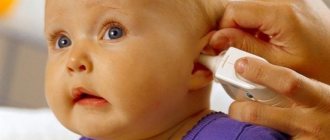How to clear your nasal passages
In the first months of life, babies do not yet know how to breathe through their mouths, and a runny nose causes severe discomfort; the child becomes capricious and eats poorly. To avoid this, it is necessary to clean the baby’s nasal passages from accumulated mucus.
It is also important to do this before putting drops into the baby’s nose, so that they have a better effect.
Many kids don’t like cleaning their nose, but this is not a reason to postpone the procedure until later.
In order for it to pass as quickly as possible, you need to prepare everything you need in advance.
To clean your nose you will need:
- Sterile cotton wool. You can also use cotton pads.
- Saline solution. You can buy it at any pharmacy or prepare it yourself. Instead, you can purchase Aquamaris or other nasal cleaners approved for use in newborns.
- Vaseline oil.
- Rubber bulb or children's nasal aspirator.
Before carrying out the procedure , it is necessary to wash your hands with soap so as not to introduce an infection into the baby’s nasal passages.
It is best if someone helps you, since the baby’s head needs to be fixed so that he does not twist it, and you do not accidentally damage the nasal passage.
Important! The procedure is prohibited if there is nosebleed.
It is necessary to drip the newborn's nose with saline using a pipette, 1-2 drops into each nostril. It will help soften dried crusts and help in cleaning thick nozzles.
Small flagella are made from cotton wool; they are used if the baby’s nose is not very stuffy and you need to remove dried snot from the nasal passage. To soften them, the flagellum can be dipped in Vaseline oil. You should not use a large amount of oil, since when the baby inhales, some of the oil may enter the lungs and cause complications.
If a child has a severe runny nose, then an aspirator to remove accumulated mucus.
What can you put in a newborn's nose?
It is important not only to free the baby’s nasal passage from mucous secretions in a timely manner, but also to choose the right vasoconstrictor drug for instillation. Experts do not recommend choosing a remedy to ease breathing on your own, since each specific case requires individual prescriptions. A slight excess of the dose of the medicine can lead to poisoning of the infant, so the drops must be used in accordance with the instructions of the pediatrician.
Newborns cannot be instilled with a spray, which is due to the structural features of the nasopharynx. The baby's passages are small in size, sufficiently wide, and they are not capable of becoming an obstacle to the inner ear. When using drugs with nebulizers, the medicine can immediately get deep inside, which can lead to the development of severe otitis media.
Medicines are often associated with side effects after their use, so young parents use proven traditional medicine to apply nasal drops to their infants. The saline solution recipe most often used for these purposes is:
- 0.5 cups of boiled chilled water;
- 0.5 tsp table salt.
A cotton swab is well moistened with the solution, which is alternately placed in each nostril of the child for a few seconds. This remedy helps relieve swelling of the mucous membrane and normalize breathing.
An equally effective and safe way to improve the passage of a baby’s nose is instillation of breast milk. To do this, it is diluted in equal proportions with boiled water. Milk cannot be used undiluted, as this will lead to the formation of crusts on the surface of the newborn’s nasal mucosa.
How to put nose drops correctly
For infants, the nose is buried in a lying position. If the child is very active or very capricious, then you can place him half-sitting on your lap and tilt his head back slightly.
According to the instructions, the required number of drops is taken into the pipette. In order to instill drops into the left nostril, the baby’s head must be tilted to the right and vice versa.
After the product is instilled, you need to hold the child in a lying position for a while so that the droplets flow evenly down the nasal passages.
What can you put in your nose?
Drops should be prescribed by a specialist, since different drops are prescribed for different types of runny nose.
To bury a child's nose, use:
- Various rinsing solutions. As a rule, they are based on sea salt. At the pharmacy you can buy sea water, saline solution, Aquamaris and other products.
- Antibiotic drops . They are prescribed if a runny nose does not go away for a long time, the mucus is thick yellow-green in color.
- Vasoconstrictor drops. They fight the runny nose very effectively, but they should not be taken for more than 4 days due to possible addiction.
- Hormonal drops are usually used for allergic rhinitis.
- Immunomodulatory drops are used to prevent influenza and ARVI.
It should be borne in mind that many products according to the instructions must be stored in the refrigerator, but taking them cold is prohibited. In this case, there is no need to heat the entire bottle. The required amount of content is poured into a heated spoon or heated in a water bath.
After instillation, to achieve a greater effect, you should massage the wings of the nose.
Important! Drops in the form of sprays are prohibited for use in infants due to the risk of otitis media and other complications.
Features of the procedure
These procedures have a number of their own characteristics:
- In order to reduce your baby's stress , you should distract him in every possible way with rattles, songs, or whatever he likes.
- Drops should be at room temperature . In addition, they must be measured with a dosed pipette, so as not to accidentally drop in more drops and cause an overdose.
- The procedure must be carried out regularly , because the baby does not yet know how to blow his nose and mucus flows down the throat. This can provoke infection and the development of disease.
- Because the dropper is inserted into the nostril , any drops must be used individually and should not be given to other people.
- To prevent the product from spilling out , after instillation, the nostril must be pressed against the nasal septum for a couple of seconds.
What not to do:
- You cannot replace cotton swabs with cotton swabs, because the latter can cause injury to the nasal mucosa and push dried mucus deeper into the nasal passage.
- Under no circumstances should you put drops in the nose of a sleeping child.
Thus, the procedure for burying a child’s nose is not as complicated as it seems at first glance. If you are afraid of doing something wrong and harming your baby, you can always seek qualified help from a specialist.
Timely, precisely selected treatment will help avoid complications.
Childhood is never complete without a runny nose. Any parent, faced with this problem, is looking for ways to solve it. Let's try to figure out how to properly put drops in a child's nose and which nasal drops are suitable for a newborn and infant.
Before putting drops in your child’s nose, prepare everything you need:
- solution (saline) for washing;
- Vaseline oil, if there are crusts;
- nasal drops;
- 1 sterile pipette;
- electric suction or baby aspirator;
- clean handkerchief.
How to put drops into your nose correctly: algorithm and technique
Stuffy nose is a common problem among adults and children. It can be solved quickly and easily with the help of drops. However, a positive effect from the use of nasal medications will be achieved if you know how to properly apply nasal drops for treatment and prevention purposes.
How to choose the right nasal drops
Before you go to the pharmacy for nasal drops, you need to determine the cause of your runny nose (sinusitis, sinusitis, allergic rhinitis, and others), depending on which the drug is prescribed.
All nasal drops are divided into three groups:
- antiviral,
- antibacterial,
- vasodilators.
Most often, vasodilators are chosen, which relieve swelling of the mucous membrane, “freeing the nose.” They cannot be used for more than a week, as addiction occurs and the effect on the cardiovascular system increases.
Antiviral and antibacterial drops are used only for medical prescription for acute respiratory viral infections and acute respiratory infections.
There are also salt-based moisturizing drops that are indicated for dry mucous membranes.
Rules for nasal drops for adults
The process of nasal instillation can be presented in stages, this will make it easier to remember the technique and instill the drug correctly.
- Thoroughly clear the nose of mucus (blowing your nose, rinsing if necessary).
- Prepare the drug (it needs to be warmed to body temperature, held in your hands for several minutes).
Note! You need to blow out the mucus one by one for each nostril, without making too much effort, so as not to damage the vessels of the nasal mucosa.
- Take the correct body position (everything is described in detail below).
- Place drops into one nostril, hold your breath and do a massage (grab the wing of the instilled nostril and make circular movements).
- Tilt your head towards the dripped nostril and stay in this position for 1-2 minutes.
- Perform manipulation with the other nostril.
- Treat the instillation tool with boiling water to prevent the spread of infectious agents.
Note! Before instillation, you should stock up on handkerchiefs, as the procedure causes sneezing.
Spray instillation has its own subtleties:
- the drug is administered in a sitting or lying position,
- simultaneously inhale and inject the medicine,
- The last step is processing the tip of the bottle.
How to put nose drops in babies
It is much more difficult for young children to administer nasal drops correctly, because the procedure causes them discomfort and resistance. Sprays are not recommended for children, as they can damage the mucous membranes with a strong jet.
In general, the instillation technique is the same as for adults, but you should take a few tips into account.
Distract your child from the procedure. In no case should you make a problem out of instillation; on the contrary, you need to talk about the importance of using the drug in the form of a fairy tale or a casual conversation.
We clean the nose without any fuss. Often, preliminary cleaning of the nasal passage causes the child to cry. Let your child (if he is able) clean his own nose.
Note! To clean the baby's nose, use weak saline solutions, cotton swabs or flagella. If the mucus is liquid, you can do without solutions.
Comfortable body position. The most comfortable position for putting drops into a child’s nose is the lying position. This will make it convenient for him to turn his head towards the dripped nostril.
An important nuance. Do not allow nasal medication to come into contact with the skin near the nose so that it does not cause irritation. If this happens, the skin must be treated with clean water.
We bury the nose of a newborn
For parents of infants, the question “how to put nose drops correctly” is especially relevant, because they have to regularly irrigate the nose and clear it of mucus. The fact is that for some time after birth, the baby secretes mucus even without a cold or other illness; it is very important to remove it in time. In this case, nasal drops are administered to moisturize the mucous membrane.
The procedure begins with washing hands by adults. Next, you need to clean the newborn’s nose; you can use saline solution or boiled water at room temperature. To do this, the child is placed on his back, then manipulation is carried out, turning the child's head in the appropriate directions. Mucus is easily removed using special devices that are available in every pharmacy.
After cleaning, you can instill the medicine prescribed by your doctor (if necessary). The manipulation scheme is the same as for cleaning. The entire procedure takes from 10 to 15 minutes.
Body posture when using nasal drops
The nose can be instilled while sitting or lying down. The body position is selected depending on the conditions in which the patient is located. The ideal body position is lying down, taking it, you need to remember that:
- you need to lie on your back,
- no need to place a pillow under your head (this way the drops will get to their destination),
- the head tilts back a little,
- the head should be turned towards the nostril that is about to be instilled,
- after instillation, you need to stay in a lying position for 10-15 minutes, you cannot get up immediately.
The introduction of antibacterial and hormonal drops involves tilting the head to the point where the nostrils “look” at the ceiling. After administering the drops, the patient should take a standing position and lower his head down. This way the medicine will be evenly distributed throughout the mucous membrane and will give the best result.
If the drops are administered in a sitting position, the patient should also tilt his head back and then tilt it to the sides.
Features of nasal instillation for sinusitis
Sinusitis occurs due to the development of inflammatory processes in the mucous membrane of the maxillary sinuses. These cavities are connected to the nasal passages, so they are also treated with drops.
The technique of nasal instillation for this disease is dictated by anatomical features. Drops should be administered in a lying position with the head slightly tilted back. The head must be turned slightly and the product must be injected into the nostril, which is closer to the surface where the patient lies.
As in other cases, before injecting drops into the nose, it is necessary to clear the nasal cavity of mucus, but this must be done without much effort so as not to harm the mucous membrane.
Nuances that should not be forgotten
Much has already been said about the instillation procedure, but you need to know about these rules so as not to harm your body.
Rule #1 . Most nasal products require storage in a cool place. It is not recommended to use them without heating the palm. You can heat a small dose of the drug in a spoon, and then drop it into your nose using a pipette.
Rule No. 2 . The dropper or bottle of medicine is intended for individual use; there is no need to transfer your germs to other people. Make sure that there are no defects on the pipette or the tip of the bottle.
Rule No. 3 . You should not put drops in the nose of a sleeping child.
Rule No. 4 . Don't forget to keep your hands clean. Before the procedure, they need to be washed with soap. This rule is of particular importance when administering nasal drops to infants.
Rule No. 5 . After completing a course of treatment with nasal medications, you need to take care of the restoration of the mucous membrane. The doctor will tell you how to do this correctly, based on the condition of the nasal cavity.
Common mistakes when instilling
These errors significantly reduce the effectiveness of the drug, negatively affecting the results of instillation:
- instillation without cleaning the nasal passages (the medicine simply does not reach the mucous membrane),
- incorrect body posture,
- non-compliance with the time interval between instillation of the nostrils (premature turning of the head),
- a sharp breath while injecting the drug,
- treatment with the same drug for more than 10 days.
Take the time to use the correct technique for nasal instillation for both adults and children, and you will avoid complications of the disease.
Rule 1. How to instill correctly?
The baby should be placed on your lap on your back and your head slightly tilted back. Take the required number of drops into the pipette. Gently drop first into one nostril, then into the second. You can also lay the baby on its side and drop it into the nose using the method described above.
Take your time so as not to damage the mucous membrane. In children, it is loose and abundantly supplied with blood vessels, which can be complicated by nosebleeds.
Before 1 year of age, nasal drops in the form of sprays should not be used. The ear canal is close to the nasal canals, and you may damage your hearing.
If we talk about an older child, then everything is much more difficult. It is better to place the child on his side. Apply drops first into one nostril, then into the second. You can lay the baby on his back and turn his head to the side.
The baby already understands what you want to do and will run away wherever his eyes look. Therefore, he needs to be mentally prepared. First, distract him by playing hospital or something he loves very much.
Before putting it into your nose, be sure to wash your hands to avoid further infection.
How to do it
Putting drops on your child’s nose is a recommendation faced by all parents whose child has contracted ARVI. After all, at this time his nose is very stuffy and he has a runny nose. From the nasopharynx, an infection without treatment can spread further and go into the ears. Therefore, the instillation procedure cannot be neglected. However, this must be done correctly, because this can further harm the child’s health.
It is especially important to follow the rules when putting drops into the nose of an infant. After all, all the passages in his nasopharynx are still small and are too close to each other, so that if the tactics are incorrect, the drops can easily flow in the wrong place.
There are two options for how to properly instill drops into a child’s nose.
Rule 2. Requirements “to the nose”
It is recommended to clean your nose first. This is done so that the drops fall on the mucous membrane itself, and not on the discharge. Accordingly, the maximum therapeutic effect is achieved.
The most common method of preparing the nose is saline solutions. Aqualor baby or Aquamaris, sea water in all its forms (soft shower sprays, drops) or regular saline solution.
Their use allows not only to wash away all excess, but also to potentiate the therapeutic effect of other drops. Remove all excess with Otrivin baby aspirate or a regular rubber bulb. Place medicinal drops into a clean nose.
Drops should:
- be at room temperature;
- current expiration date;
- have no age contraindications;
- better with a dosed pipette.
Rule 3. What to put in your nose?
There are a lot of all kinds of drops on the modern pharmacological market. Let's look at what you can put in your child's nose.
- Solutions for washing - sea water, saline solution. Designed to rinse the nose from mucus and soften crusts.
- Drops with antibiotics - Isofra, Polydex. When a child has a long runny nose (more than 10 days), and the nasal discharge is thick and green, then these droplets come to the rescue.
- Vasoconstrictor drops – Nazivin baby, Ximelin. Good for congestion. It is better to use no more than 5 days.
- Drops with hormonal properties - Nasonex. Used in the treatment of allergic rhinitis.
- Drops with an immunomodulatory component - Derinat, Grippferon. Can also be used as a prophylaxis against ARVI.
Do not draw up a full dropper of medication. You can overdose!
Physiological runny nose
Newborn babies have a number of characteristics. Sometimes mothers notice nasal congestion and snoring in their sleep. This does not mean that the child is sick. Simply after birth, the nasal passages are cleared of accumulated mucus.
To reduce the manifestations of nasal congestion in an infant, you must:
- ventilate the room where the newborn is located;
- humidify the air by placing jars of water or hanging wet diapers, or using special air humidifiers;
- rinse the nasal passages with sea water.
How and what drops should be used
Typically, the treatment regimen for nasal congestion in children is quite standard.
Typically, the treatment regimen for nasal congestion in children is quite standard. First, rinse and moisten your nose with seawater drops. Alternatively, you can prepare a solution for washing yourself - just dilute 1 teaspoon of regular salt (if it’s sea salt, even better) in a liter of boiled water. This solution can be instilled a couple of drops with a pipette. Then it is recommended to blow your nose. Mothers of very young children can use a snot pump.
Vasoconstrictor drugs are then usually used. They help relieve congestion and promote the passage of mucus through the nasopharynx. You should be more careful with vasoconstrictor drugs. After all, they have a very strong effect on the entire body, leading to a narrowing of many important blood vessels. This means that under no circumstances should you exceed the indicated and prescribed dosage - there are cases where, after instilling a full pipette into one nostril, children ended up in the hospital. After them, you can successfully use medicinal drops. The latter may include drying drugs with silver, Miramistin and others, as prescribed by the doctor.
It is worth considering the fact that drops can be used by people of all ages, but only these can be used by babies. Sprays will cause mucus to flow into the ear canals, which quite often leads to the development of otitis media. If the complex effect does not have the desired effect within 7 days, the drops must be changed, because this means that the body is either resistant to them or has become accustomed to them.
Psychological aspects
Kids rarely like it when something drips into their nose or ears. Therefore, mother must be patient and calm. Talk to the child, explain that he will not be hurt, that you are nearby. Tell us why this is needed.
For children over 3 years old, you can turn everything into a game. Show how you drip to dad, your favorite bunny or other toy, and that no one cries or runs. Rattles, toys, cartoons - a complete arsenal of how to distract a child.
Self-medicating is the wrong choice. Only a pediatrician can adequately assess the baby’s condition. Each child is individual, so nasal drops should be used strictly according to the doctor’s recommendation.
If you have nosebleeds, you should not put any drops into your nose.
Walk more in the fresh air, play, bathe your baby. And these unpleasant procedures will be avoided.
Young parents should remember that dry nasal mucosa is unacceptable. It is necessary to clean or rinse the spout 2 times a day, especially for infants.
A newborn appeared in the house. For inexperienced parents, everything is new – how to feed a newborn, how to care for a baby. And if the baby has nasal congestion (bugs) or a runny nose, then the question comes to the fore - how to bury a newborn’s nose or how to properly clean a baby’s nose.
First of all, you need to consult a pediatrician. However, in our time, already in the maternity hospital, a young mother is taught the technique of caring for a child, including she should already know how to put drops in the nose of a newborn. (How to instill drops in a child)
Nasal congestion in babies must be dealt with immediately. The fact is that the nasopharyngeal system of a newly born child is not fully developed, so the slightest disease will cause much more harm to the baby than to an adult. In addition, a runny nose easily takes a chronic form and can spread to the inner ear, giving your baby also otitis media.
In addition, a newborn feeds a large number of times per day, while he wraps his lips around the nipple and eats. And the presence of a runny nose will not allow the baby to eat normally.
So, how to properly put drops in a newborn's nose?
- First you need to cleanse your nasal passages. To do this, place the child on his back, turn his head slightly to the side and drop one or two drops of saline solution or ordinary boiled water with a pipette.
- Then turn the head to the other side and do the same procedure. You need to wait about one minute for the contents of the small spout to soften.
- Then you need to use a vacuum aspirator. It looks like a small pear. It is necessary to squeeze the aspirator bulb to release the air from it. Then carefully insert the tip of the aspirator into the small nostril and release the bulb. During this action, the characteristic sound of the contents being sucked out should be heard.
- Rinse the aspirator of mucus and do the same with the other nostril.
There is no need to worry about the baby crying and dodging - the whole procedure will take a maximum of half a minute, so it is better to quickly clean the nose and calm the baby.








